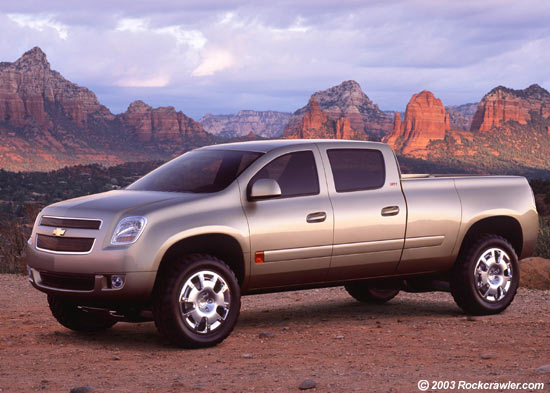|
Tilted Cat Head
Administrator
Location: Manhattan, NY
|
Concept Car:
 
 
  link
link
Quote:
Chevrolet's 2003 Cheyenne Concept
DETROIT - The 2003 Chevy Cheyenne is the latest example of this tradition of innovation. Inspired by a rich heritage of breaking new ground in function and style, the thunderstone metallic Cheyenne is a statement of what a new generation of full-size trucks can be. Cheyenne combines ruggedly elegant styling with new levels of cargo-carrying versatility for personal and business use.
"The Cheyenne's mission is to provide a vision of the evolution of the full-size truck," said Ed Welburn, GM's executive director of design for body-on-frame. "This vision builds on the equity of Chevy's tough and rugged image while adding more versatility and refinement."
Strong heritage
As GM designers reviewed the heritage of Chevy trucks, certain generations left strong impressions, most notably the 1955 Cameo, the 1967 and 1973 Cheyennes, and the 1988 Silverado.
"These trucks featured a purity of form and purpose, and exuded class and elegance," said Jeff Angeleri, Cheyenne's exterior designer. "We wanted to communicate rugged elegance by creating an integrated, refined, muscular exterior with flowing flared wheel arches connected to soft yet tense body forms."
A significant component of "rugged elegance" is the Cheyenne's proportions, created by focusing on the interior environment of the cab and maximizing the visible space for versatility and comfort. The cab is thrust forward on the extruded aluminum chassis for a more commanding presence. Positioning the wheels at the corners telegraphs stability and cargo capability.
Cheyenne uses an independent rear suspension and rear-wheel-steering system, similar to the QS4 system used in some of today's GM vehicles, for enhanced maneuverability. Together, the two innovations help enable the Cheyenne's next mission - function.
Innovative cargo box
"A significant area of opportunity to innovate is in the cargo box of the truck," Angeleri said. "We saw that if we could significantly add to the usable function there, we could truly gain an advantage and provide the truck customer with even more value."
The bed is accessible by two side-access doors positioned directly behind the cab, in addition to a traditional tailgate.
The tailgate has evolved to open fully in the traditional manner, or half open for loading small cargo or to create a work shelf. The bed floor is just 28 inches above the ground, significantly lower than even today's two-wheel-drive Silverado. This was made possible by the independent rear suspension configuration.
"This allows the box to be more versatile in loading all sorts of cargo, from motorcycles to construction materials," Angeleri said.
Also integrated into the pickup box are multiple storage bins in the box floor and drawers in the box sides. The box is equipped with lighting and integrated tie-downs throughout for maximum versatility in all conditions.
Luxurious interior
"The interior cab features simplicity of surface and enhanced functionality, and creates a sense of open space," said Cheyenne interior designer, Wayne Manista. The instrument panel is low and uncluttered. The seat mechanism is integrated into the floor to provide more usable foot room.
The seats and headliner are covered in luxurious mottled saddle, handcrafted leather. Brushed, satin-finish aluminum inlays in the doors and floor add polish, creating an overall effect of up-country gentility.
A drop-down assist step, developed in partnership with Amp Research, maximizes entry and egress. The two-panel glass roof, with integrated sunroof, and the wrap-around, "bubble back" rear glass, accentuates the cab's openness. Manista borrowed from the 1955 Cameo for the Cheyenne's bubble-back rear glass.
Supercharged V-8 engine
The hood is a front-hinged clamshell design that opens to provide full access to the front compartment, including the supercharged all-alloy 6.0-liter Vortec engine, which generates 500 horsepower and 580 lbs.-ft. of torque. The V-8 engine also is suitable for GM Powertrain's Displacement on Demand (DOD) technology,debuting in 2004 on some 2005 GM models. DOD shuts down half of the cylinders during most driving conditions, and automatically and seamlessly reactivates them for more demanding conditions, such as brisk acceleration or load hauling. When opened, the hood also exposes the all-new aluminum alloy control arms and Fox coil-over remote reservoir shocks, which provide Cheyenne immense off-road capability as well as refined manners.
Cheyenne rides on unique BF Goodrich 35-inch tires mounted to 22-inch wheels. Six-piston calipers with 15-inch rotors on the front wheels slow the truck, along with four-piston calipers with 14.75-inch rotors on the rear.
|
seems a bit too squished for the cab design and if they have those side doors then how do people put their tools in the extreme rear?
__________________
I don't care if you are black, white, purple, green, Chinese, Japanese, Korean, hippie, cop, bum, admin, user, English, Irish, French, Catholic, Protestant, Jewish, Buddhist, Muslim, indian, cowboy, tall, short, fat, skinny, emo, punk, mod, rocker, straight, gay, lesbian, jock, nerd, geek, Democrat, Republican, Libertarian, Independent, driver, pedestrian, or bicyclist, either you're an asshole or you're not.
|